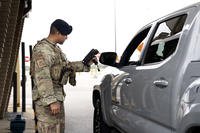Army Futures Command, or AFC, will soon decide whether weapons officials will get another shot at equipping infantry squads with a precision airburst weapon for killing enemy forces hiding behind cover.
Maneuver officials at Fort Benning, Georgia, announced in November that the Army would pursue the Precision Grenadier program to create a new weapon for launching explosive projectiles at enemies in defilade positions.
In the next couple of months, maneuver officials are scheduled to present a proposal for the effort to AFC commander Gen. Mike Murray for approval to move forward with the effort, Lt. Col. Christopher Kennedy, chief of the Lethality Branch at Benning, told defense industry officials Wednesday at the Maneuver Capabilities Development and Integration Directorate's Industry Day.
Read Next: Charles Coolidge, Medal of Honor Recipient Who Fought Boldly in WWII, Dead at 99
"This one here is really getting after our biggest issue when it comes to lethality," Kennedy said. "When the first rounds start flying, every firefight becomes a defilade fight. ... You are getting behind rocks, trees, vehicles, whatever; you are putting something between you and the enemy who is shooting at you and putting yourself in a defilade position."
And the enemy does the same thing, he said.
"I want something that I can employ almost anywhere and affect that enemy that is in defilade," Kennedy explained. "To us, that really means an air-bursting round, a round that I can tell, 'Hey, the enemy is at 142 meters -- go 143 meters and then explode' ... and put something on him that is either going to kill him or make him stop firing at us."
This is not the Army's first attempt to solve this problem.
During the past decade, the service tried to field the XM25 Counter-Defilade Target Engagement System to expand the infantry squad's effectiveness at killing enemies behind cover.
The XM25 was a semi-automatic, shoulder-fired weapon that fired 25mm high-explosive, air-bursting ammunition. The sophisticated weapon, known as the "Punisher," stirred excitement in the infantry community. But in the end, the complex system was plagued by program delays and became a target for Pentagon auditors.
The Army ended the contract with Orbital ATK in 2017, which led to the death of the program.
Currently, two infantrymen in each squad are armed with an M4A1 carbine with a single-shot M320 40mm grenade launcher attached for engaging enemies in defilade or behind cover, an outdated system that maneuver officials argue is unsuited for the counter-defilade fight.
"We are really looking for that flat trajectory, high-velocity, multi-shot system," Kennedy said. "We are going to go in front of Gen. Murray, and he is either going to tell us that we have permission to move forward or not. ... I expect in the next couple of months for things to really move fast."
Kennedy did not have many details about the proposed system.
"I don't have a caliber; you guys are going to come up with the caliber," he said. "Industry is going to come back and tell me ... 'Here's what I've got.'"
The Army wants a weapon capable of engaging enemy positions just beyond hand grenade range of 35 meters out to 500 meters.
"Really, the sweet spot is in that 300-meter range band -- being able to affect the enemy and engage him in defilade," Kennedy said. "And we are looking to do that in less than 15 seconds."
-- Matthew Cox can be reached at [email protected].
Related: Army Still Wants a Precision Infantry Weapon to Destroy the Enemy From Behind Cover













